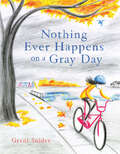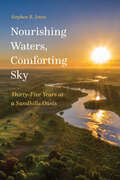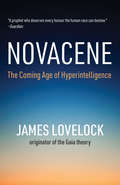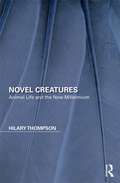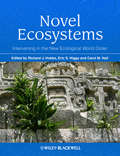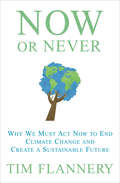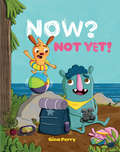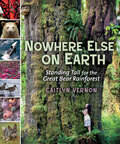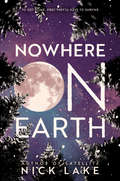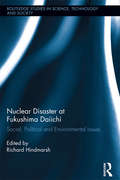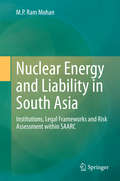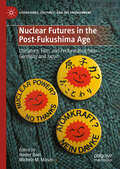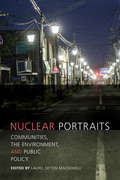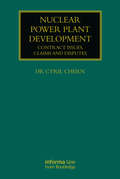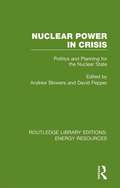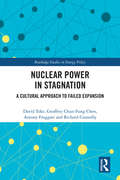- Table View
- List View
Nothing Ever Happens on a Gray Day
by Grant SniderWith fantastic bursts of color and lyricism, Grant Snider explores the extraordinary within the ordinary in this ode to seemingly boring days and the wonders that emerge for anyone open to seeing them. The sky is gloomy and the world feels like it's asleep . . . but perhaps all that's required for adventure is a bit of curiosity and patience. After all, an everyday stroll can become an adventure in the blink of an eye. On a day when even the rain is too bored to fall, ride alongside a girl on her rickety bicycle through the familiar scenes of her neighborhood as she rediscovers the colors—a splash of yellow, a flash of red, a flutter of blue—that can be found even when all seems monochrome. In this artful picture book that celebrates do-nothing days and solitary adventures, readers learn how embracing quiet stillness with openness and curiosity can make space for unexpected encounters, meaningful detours, and some of life's most unforgettable moments. With luminous illustrations that practically glow on the page, Grant Snider takes readers on a visual journey they'll want to return to again and again.TEACHING MINDFULNESS FOR KIDS: Grant Snider's luminous illustrations will captivate even the most restless young readers, while the story subtly teaches the benefits of patience, silent observation, and mindful awareness.CONNECTING WITH NATURE: Both art and story will inspire children to approach nature with reverence and wonder, explore the outdoors, and learn more about their local environment.OVERCOMING BOREDOM: Themes of childhood boredom and loneliness are addressed in a gentle and heartfelt way, encouraging a spirit of exploration, curiosity, and connection with the natural world. RAINY DAY LOVERS: For those who appreciate the coziness and comfort of a rainy day, this book is a must-have. STORYTIME READ-ALOUD: The gentle pace and lilting rhythm make this a soothing read for storytime at home, at school, or in a library.Perfect for:Parents and grandparents of introspective, introverted, or independent daydreamersReaders who enjoy kids adventure stories and books about natureFamilies and classrooms seeking a great read-aloud bookFans of Grant Snider's previous titles, including What Color Is Night?, What Sound Is Morning?, and There Is a Rainbow
Nourishing Waters, Comforting Sky: Thirty-Five Years at a Sandhills Oasis
by Stephen R. JonesIn the Nebraska Sandhills, ranchers on horseback and in pickup trucks share the range with pronghorn antelope, burrowing owls, and long-billed curlews. The native grasses grow greener as the cattle grow fatter. Throughout the region, river otters and mink swim in streams nourished by springs bubbling up from the High Plains (Ogallala) aquifer. Over years of close observation, Stephen R. Jones has gotten to know the Nebraska Sandhills—the twenty-thousand-square-mile expanse of stunning prairie and thriving wetlands. He has felt the warm breath of a white-tailed doe guarding her spotted fawn, learned to communicate with a family of long-eared owls, and developed an improbable hiking relationship with a wild turkey. He has documented a breeding bird population that is growing more diverse and witnessed the long-awaited return of nesting trumpeter swans. These personal stories, accompanied by words of insight from Native American leaders, Sandhills ranchers, and grassland ecologists, help us envision a quiet relationship with the natural world.
Nourishment: What Animals Can Teach Us about Rediscovering Our Nutritional Wisdom
by Fred Provenza&“Nourishment will change the way you eat and the way you think.&”—Mark Schatzker, author of The Dorito Effect&“[Provenza is] a wise observer of the land and the animals [and] becomes transformed to learn the meaning of life.&”—Temple GrandinReflections on feeding body and spirit in a world of changeAnimal scientists have long considered domestic livestock to be too dumb to know how to eat right, but the lifetime research of animal behaviorist Fred Provenza and his colleagues has debunked this myth. Their work shows that when given a choice of natural foods, livestock have an astoundingly refined palate, nibbling through the day on as many as fifty kinds of grasses, forbs, and shrubs to meet their nutritional needs with remarkable precision.In Nourishment Provenza presents his thesis of the wisdom body, a wisdom that links flavor-feedback relationships at a cellular level with biochemically rich foods to meet the body&’s nutritional and medicinal needs. Provenza explores the fascinating complexity of these relationships as he raises and answers thought-provoking questions about what we can learn from animals about nutritional wisdom.What kinds of memories form the basis for how herbivores, and humans, recognize foods?Can a body develop nutritional and medicinal memories in utero and early in life?Do humans still possess the wisdom to select nourishing diets or has that ability been hijacked by nutritional &“authorities&”?Is taking supplements and enriching and fortifying foods helping us, or is it hurting us?On a broader scale Provenza explores the relationships among facets of complex, poorly understood, ever-changing ecological, social, and economic systems in light of an unpredictable future.To what degree do we lose contact with life-sustaining energies when the foods we eat come from anywhere but where we live?To what degree do we lose the mythological relationship that links us physically and spiritually with Mother Earth who nurtures our lives?Provenza&’s paradigm-changing exploration of these questions has implications that could vastly improve our health through a simple change in the way we view our relationships with the plants and animals we eat.&“Nourishment is a conversation between science, culture, and a greater spiritual or cosmological umbrella.&”—Montana Public Radio
Novacene: The Coming Age of Hyperintelligence (The\mit Press Ser.)
by James LovelockThe originator of the Gaia theory offers the vision of a future epoch in which humans and artificial intelligence together will help the Earth survive.James Lovelock, creator of the Gaia hypothesis and the greatest environmental thinker of our time, has produced an astounding new theory about future of life on Earth. He argues that the Anthropocene—the age in which humans acquired planetary-scale technologies—is, after 300 years, coming to an end. A new age—the Novacene—has already begun.In the Novacene, new beings will emerge from existing artificial intelligence systems. They will think 10,000 times faster than we do and they will regard us as we now regard plants. But this will not be the cruel, violent machine takeover of the planet imagined by science fiction. These hyperintelligent beings will be as dependent on the health of the planet as we are. They will need the planetary cooling system of Gaia to defend them from the increasing heat of the sun as much as we do. And Gaia depends on organic life. We will be partners in this project.It is crucial, Lovelock argues, that the intelligence of Earth survives and prospers. He does not think there are intelligent aliens, so we are the only beings capable of understanding the cosmos. Perhaps, he speculates, the Novacene could even be the beginning of a process that will finally lead to intelligence suffusing the entire cosmos. At the age of 100, James Lovelock has produced the most important and compelling work of his life.
Novel Creatures: Animal Life and the New Millennium (Perspectives On The Non-human In Literature And Culture Ser.)
by Hilary ThompsonNovel Creatures takes a close look at the expanding interest in animals in modern fiction and argues that the novels of this time reveal a dramatic shift in conceptions of "creatureliness." Scholars have turned to the term "creaturely" recently to describe shared aspects of human and animal experience, thus moving beyond work that primarily attends to distinctions between the human and the animal. Carrying forward this recent scholarship, Novel Creatures argues that creatureliness has been an intensely millennial preoccupation, but in two contrasting forms—one leading up to the turn of the century, the other after the tragic events of 9/11.
Novel Ecosystems
by Eric S. Higgs Carol Hall Richard J. HobbsLand conversion, climate change and species invasions are contributing to the widespread emergence of novel ecosystems, which demand a shift in how we think about traditional approaches to conservation, restoration and environmental management. They are novel because they exist without historical precedents and are self-sustaining. Traditional approaches emphasizing native species and historical continuity are challenged by novel ecosystems that deliver critical ecosystems services or are simply immune to practical restorative efforts. Some fear that, by raising the issue of novel ecosystems, we are simply paving the way for a more laissez-faire attitude to conservation and restoration. Regardless of the range of views and perceptions about novel ecosystems, their existence is becoming ever more obvious and prevalent in today's rapidly changing world. In this first comprehensive volume to look at the ecological, social, cultural, ethical and policy dimensions of novel ecosystems, the authors argue these altered systems are overdue for careful analysis and that we need to figure out how to intervene in them responsibly. This book brings together researchers from a range of disciplines together with practitioners and policy makers to explore the questions surrounding novel ecosystems. It includes chapters on key concepts and methodologies for deciding when and how to intervene in systems, as well as a rich collection of case studies and perspective pieces. It will be a valuable resource for researchers, managers and policy makers interested in the question of how humanity manages and restores ecosystems in a rapidly changing world.A companion website with additional resources is available at www.wiley.com/go/hobbs/ecosystems
Now Is the Time for Trees: Make an Impact by Planting the Earth's Most Valuable Resource
by Arbor Day Foundation Dan Lambe&“Celebrates the power of trees to oxygenate the planet, purify water and air, lower city temperatures, provide habitat, nurture the soul, and provide essential food sources.&” —Booklist Trees and forests are the number one nature-based solution for reversing the negative effects of a changing climate. If ever there was a time to be planting trees, that time is now. Inspired by a collective sense of urgency, a global movement to plant trees is gaining momentum. To move the needle, we need to act on a massive scale and plant millions of trees today to have a measurable and lasting impact on billions of lives tomorrow. In Now Is the Time for Trees, the experts at the Arbor Day Foundation will inspire you to do your part by showing you everything you need to know to plant trees at home or in your community. From advice on choosing the right size and type of tree to tried-and-true tips for planting success, this book will help you plant a tree today and leave your own legacy of hope. Equal parts inspiration and advocacy, Now Is the Time for Trees is a rousing call for environmental action and a must-have book for nature lovers everywhere.
Now You Know What You Eat
by Valorie FisherFrom peanut butter and jelly sandwiches to macaroni and cheese, Valorie Fisher explores the science behind our most delicious dishes!Valorie Fisher dives deep into the science of what we eat and where ingredients come from by exploring what happens behind the scenes of favorite, everyday foods like pizza, honey, milk, maple syrup, vegetable soup, and more! With the help of bold, eye-catching yet simple graphics, inquisitive minds will love discovering what makes popcorn pop, why bread rises, and how bees make honeycomb. With this book peppered with facts like how many eggs a hen lays in a year and how many gallons of sap it takes to make one gallon of syrup, readers will be fascinated by all the amazing things they never knew about the food they eat! Now You Know What You Eat also includes a glossary, and a graphic about the food groups, as well as an introduction to vitamins and minerals. With a growing focus on STEM for this early age group, this book encourages readers to ask their own questions about the world around them, and to fall in love with discovering the answers!
Now or Never: Why We Must Act Now to End Climate Change and Create a Sustainable Future (Quarterly Essay Ser. #No. 31)
by Tim FlanneryIn Now or Never, the internationally acclaimed author of The Weather Makers returns to the subject of climate change with a book that is at once a forceful call to action and a deeply (and often surprisingly) pragmatic roadmap toward sustainability. Utilizing the most up-to-the-minute data available, Tim Flannery offers a guided tour of the environmental challenges we face and their potential solutions in both the big picture and in specific detail. He explores everything from techniques for storing the carbon that dead plants release into the earth to the fragile balancing act between energy demands and food supply in India and China, from carbon-trading schemes in South America to a recent collaboration between a Danish wind-energy company and an automobile manufacturer that may produce a viable electric car and end the reign of big oil. Now or Never is a powerful, thought-provoking, and essential book about the most urgent issue of our time. It burns with Flannery’s characteristic mix of passion, scientific precision, and "offhand interdisciplinary brilliance” (Entertainment Weekly).
Now? Not Yet! (Mo and Peanut)
by Gina PerryPeanut and Moe are back, this time on a camping trip. Peanut wants to swim NOW, Moe says NOT YET! A sweet and cheerful book about overcoming differences.Peanut and Moe are back! Peanut says let's swimMoe says time to hikePeanut says let's swim nowMoe says time to eat a snackPeanut says now!Moe says time to put up the tentPeanut says NOW!Moe says NOT YET!Can these two friends come together in time to save their camping trip?
Nowhere Better Than Here
by Sarah GuilloryIn a town slowly being destroyed by rising tides, one girl must fight to find a way to keep her community’s spirit from drowning.For thirteen-year-old Jillian Robichaux, three things are sacred: bayou sunsets, her grandmother Nonnie’s stories, and the coastal Louisiana town of Boutin that she calls home.When the worst flood in a century hits, Jillian and the rest of her community band together as they always do—but this time the damage may simply be too great. After the local school is padlocked and the bridges into town condemned, Jillian has no choice but to face the reality that she may be losing the only home she’s ever had.But even when all hope seems lost, Jillian is determined to find a way to keep Boutin and its indomitable spirit alive. With the help of friends new and old, a loveable golden retriever, and Nonnie’s storytelling wisdom, Jillian does just that in this timely and heartfelt story of family, survival, and hope.In her stunning debut middle grade novel, Sarah Guillory has written a lush story about an indomitable girl fighting against the effects of climate change.
Nowhere Else on Earth: Standing Tall for the Great Bear Rainforest
by Caitlyn VernonYou don't have to live in the Great Bear Rainforest to benefit from its existence, but after you read Nowhere Else on Earth you might want to visit this magnificent part of the planet. Environmental activist Caitlyn Vernon guides young readers through a forest of information, sharing her personal stories, her knowledge and her concern for this beautiful place. Full of breathtaking photographs and suggestions for ways to preserve this unique ecosystem, Nowhere Else on Earth is a timely and inspiring reminder that we need to stand up for our wild places before they are gone. Visit http://www.greatbearrainforest.ca to find teacher and student resources, view the online photo gallery, or read a sample chapter from the book. To access the free teacher's guide for Nowhere Else on Earth, click here:http://orcabook.com/nowhereelseonearth/guides/teachersguide.pdf.
Nowhere Left to Go: How Climate Change Is Driving Species To The Ends Of The Earth
by Benjamin von BrackelHarrowing journeys of animals and plants—fleeing skyrocketing temperatures and mega-droughts—reported from the frontlines of the greatest migration of species since the Ice Age As humans accelerate global warming while laying waste to the environment, animals and plants must flee to the margins: on scattered nature reserves, between major highways, or among urban sprawl. And when even these places become too hot and inhospitable, wildlife is left with only one path to survival: an often-formidable journey toward the poles as they race to find a new home in a warming world. Tropical zones lose their inhabitants, beavers settle in Alaska, and gigantic shoals of fish disappear—just to reappear along foreign coastlines. Award-winning environmental journalist Benjamin von Brackel traces these awe-inspiring journeys and celebrates the remarkable resilience of species around the world. But the lengths these plants and animals must go to avoid extinction are as alarming as they are inspirational: Sea animals—like fish—move on average 45 miles a decade to cooler regions, while land animals—like beavers and butterflies—move 11 miles. As even the poles of the Earth heat up, we’re left with a stark and irreversible choice: Halt the climate emergency now, or face a massive die-off of species, who are increasingly left with nowhere else to go.
Nowhere on Earth
by Nick LakeFrom the Printz Award-winning author of Satellite comes a compelling new novel about a girl who must brave the elements to help a lost child with an otherworldly secret.Sixteen-year-old Emily is on the run. Between her parents and the trouble she's recently gotten into at school, she has more than enough reason to get away. But when she finds a little boy named Aidan wandering in the woods, she knows she needs to help him find his way home. But getting home is no easy matter, especially when Emily finds out that Aidan isn't even from Earth. When their plane crashes into the side of a snowy mountain, it's up to Emily to ensure Aidan and their pilot, Bob, make it off the mountain alive. Pursued by government forces who want to capture Aidan, the unlikely team of three trek across the freezing landscape, learning more about each other, and about life, than they ever thought possible."I love Nick Lake's writing. I would read anything he wrote--grocery list, email, etc.--because his writing, always, is so real and brave. He takes on subjects other writers might avoid, and he writes the hell out of them." --New York Times bestselling author Jennifer Niven on Nick Lake
Nuclear Disaster at Fukushima Daiichi: Social, Political and Environmental Issues (Routledge Studies in Science, Technology and Society)
by Richard HindmarshNuclear Disaster at Fukushima Daiichi is a timely and groundbreaking account of the disturbing landscape of the Fukushima Daiichi nuclear meltdown amidst an earthquake and tsunami on Japan’s northeast coastline on March 11, 2011. It provides riveting insights into the social and political landscape of nuclear power development in Japan, which significantly contributed to the disaster; the flawed disaster management options taken; and the political, technical, and social reactions as the accident unfolded. In doing so, it critically reflects on the implications for managing future nuclear disasters, for effective and responsible regulation and good governance of controversial science and technology, or technoscience, and for the future of nuclear power itself, both in Japan and internationally. Informed by a leading cast of international scholars in science, technology and society studies, the book is at the forefront of discussing the Fukushima Daiichi disaster at the intersection of social, environmental and energy security and good governance when such issues dominate global agendas for sustainable futures. Its powerful critique of the risks and hazards of nuclear energy alongside poor disaster management is an important counterbalance to the plans for nuclear build as central to sustainable energy in the face of climate change, increasing extreme weather events and environmental problems, and diminishing fossil fuel, peak oil, and rising electricity costs. Adding significantly to the consideration and debate of these critical issues, the book will interest academics, policy-makers, energy pundits, public interest organizations, citizens and students engaged variously with Fukushima itself, disaster management, political science, environmental/energy policy and risk, public health, sociology, public participation, civil society activism, new media, sustainability, and technology governance.
Nuclear Energy Safety and International Cooperation: Closing the World's Most Dangerous Reactors (Routledge Studies in Environmental Policy)
by Spencer Barrett Meredith, IIITwenty-five years after the Chernobyl explosion, disaster struck once again after a tsunami overwhelmed the considerable safety measures at the Fukushima nuclear power plant in Japan. However, Fukushima had in place a solid containment structure to reduce the spread of radiation in the event of a worst-case scenario; Chernobyl did not. These two incidents highlight the importance of such safety measures, which were critically lacking in an entire class of Soviet-designed reactors. This book examines why five countries operating these dangerous reactors first signed international agreements to close them within a few years, then instead delayed for almost two decades. It looks at how political decision makers weighed the enormous short-term costs of closing those reactors against the long-term benefits of compliance, and how the political instability that dominated post-Communist transitions impacted their choices. The book questions the efficacy of Western governments’ efforts to convince their Eastern counterparts of the dangers they faced, and establishes a causal relationship between political stability and compliance behavior. This model will also enable more effective assistance policies in similar situations of political change where decision makers face considerable short-term costs to gain greater future rewards. This book provides a valuable resource for postgraduate students, academics and policy makers in the fields of nuclear safety, international agreements, and democratization.
Nuclear Energy and Liability in South Asia
by M. P. Ram MohanThis book advocates pursuing a regional approach to nuclear risk framework, which it argues is more promising in the current scenario than the non-achievable global regime. In the development of international legislation on liability, the nuclear energy sector represents an alternative approach to a transboundary liability regime. Building on this foundation and following the Chernobyl accident, international consensus was sought for a stronger transboundary legal regime in the event of a nuclear disaster. However, after sixty years of the existence of international nuclear liability laws and twenty-five years after Chernobyl, the primary objectives of the Conventions - harmonization and a global regime - remain unfulfilled. Further, many countries are now creating or expanding nuclear programs without adequate transboundary legal protection. In light of these issues, a regional approach is an option that cannot be ignored. Given its rapidly expanding nuclear energy footprint, South Asia is in a unique position to adopt a regional mechanism. The methodology adopted for the study in the book combines a literature review of international law on nuclear liability with an analysis of South Asian nuclear energy programs and their international and national legal obligations. A technical risk assessment study conducted to identify the level of transboundary nuclear risk within South Asia is also presented. This is followed by interviews with experts and policymakers to gauge the willingness of the South Asian Association for Regional Cooperation (SAARC) community to respond to this shared regional concern.
Nuclear Futures in the Post-Fukushima Age: Literature, Film, and Performance from Germany and Japan (Literatures, Cultures, and the Environment)
by Hester Baer Michele M. MasonThis groundbreaking volume explores new artistic forms that emerged in German-speaking Europe and Japan in the wake of the 2011 Fukushima nuclear power plant disaster. Considering the cultural specificity of post-3.11 literature, poetry, theater, and film, while also attending to moments of crossing, hybridity, and transference, Nuclear Futures in the Post-Fukushima Age offers a critical model for examining the intertwining of transnational connection and ecological contamination in a global present marked by renewed nuclear threat. Bringing together incisive readings by eminent scholars of Germany and Japan as well as a newly translated work by Yōko Tawada, the volume offers a comparative humanities approach that is essential for reframing debates about environmental crisis and nuclear risk.
Nuclear Law: The Global Debate
by International Atomic Energy AgencyThis open access book traces the journey of nuclear law: its origins, how it has developed, where it is now, and where it is headed. As a discipline, this highly specialized body of law makes it possible for us to benefit from the life-saving applications of nuclear science and technology, including diagnosing cancer as well as avoiding and mitigating the effects of climate change. This book seeks to give readers a glimpse into the future of nuclear law, science and technology. It intends to provoke thought and discussion about how we can maximize the benefits and minimize the risks inherent in nuclear science and technology. This compilation of essays presents a global view in discipline as well as in geography. The book is aimed at representatives of governments—including regulators, policymakers and lawmakers—as well representatives of international organizations and the legal and insurance sectors. It will be of interest to all those keen to better understand the role of law in enabling the safe, secure, and peaceful use of nuclear technology around the world. The contributions in this book are written by leading experts, including the IAEA’s Director General, and discuss the four branches of nuclear law—safety, security, safeguards and nuclear liability—and the interaction of nuclear law with other fields of national and international law.
Nuclear Portraits: Communities, the Environment, and Public Policy
by Laurel Sefton MacdowellIn the twenty-first century, nuclear energy has become a hotly contested issue. In the face of climate change, and the search for alternative forms of energy, nuclear power continues to affect the lives of communities around the world. In Nuclear Portraits, scholars from Europe, North America, and Asia demonstrate the complexity, controversy, contradictions, and dangers that surround many aspects of the nuclear industry. The resulting local, regional, national, and international concerns that arise, such as the disasters at Chernobyl and Fukushima, call into question the optimism espoused by the nuclear industry. We live in a world with more nuclear nations than ever before and energy policy is central to the mounting global concern about climate change. The innovative essays found in Nuclear Portraits will open your eyes to the realities of nuclear energy, thereby allowing you to decide for yourself whose side you are on.
Nuclear Power Plant Development: Contract Issues, Claims and Disputes (Construction Practice Series)
by Cyril ChernNuclear Power Plant Development covers the intricacies of developing a nuclear power plant project from a construction and legal standpoint. It deals with structuring, drafting, and negotiating a wide range of standard and specialised contracts relating to the development of nuclear power-generation projects and also covers the other forms of power-generating facilities. It covers the forms of contract, the law involved internationally, and potential areas of pitfalls and how to avoid them in a systematic format covering various forms of projects. It is suitable for solicitors and barristers involved in the contracting for such facilities and the handling of litigation related to them, government officials involved in the commissioning and development of nuclear facilities for regional governments, and engineers and contractors involved in the actual work of design and contract administration and dispute resolution.
Nuclear Power in Crisis: Politics and Planning for the Nuclear State (Routledge Library Editions: Energy Resources)
by David Pepper Andrew BlowersOriginally published in 1987. The Chernobyl disaster intensified the whole debate on the nuclear power industry. There was great public concern about the industry regulation, about the siting of nuclear facilities, including the dumping of nuclear waste, and about the alleged secretiveness of the industry. This book examines these and many other important aspects of the industry worldwide and provides much important original research. It focuses in particular on the political processes which control the industry, on waste disposal and on the social impact.
Nuclear Power in Stagnation: A Cultural Approach to Failed Expansion (Routledge Studies in Energy Policy)
by David Toke Richard Connolly Geoffrey Chun-Fung Chen Antony FroggattThis book studies the extent to which nuclear safety issues have contributed towards the stagnation of nuclear power development around the world, and accounts for differences in safety regulations in different countries. In order to understand why nuclear development has not met widespread expectations, this book focusses on six key countries with active nuclear power programmes: the USA, China, France, South Korea, the UK, and Russia. The authors integrate cultural theory and theory of regulation, and examine the links between pressures of cultural bias on regulatory outcomes and political pressures which have led to increased safety requirements and subsequent economic costs. They discover that although nuclear safety is an important upward driver of costs in the nuclear power industry, this is influenced by the inherent need to control potentially dangerous reactions rather than stricter nuclear safety standards. The findings reveal that differences in the strictness of nuclear safety regulations between different countries can be understood by understanding differences in cultural contexts and the changes in this over time. This book will be of great interest to students, scholars, and policymakers working on energy policy and regulation, environmental politics and policy, and environment and sustainability more generally.
Nuclear Power or a Promise Lost: A Policy Maker's Guide for a Future of Carbon Free, Sustainable Energy
by Edward T. BurnsThis book captures the status of current electrical energy markets including the principal forces affecting decisions on selecting an energy source. It represents a seminal work that lays out the electrical energy decision tree for selecting an energy sou
Nuclear Power, Economic Development Discourse and the Environment: The Case of India (Routledge Explorations in Environmental Studies)
by Manu V. MathaiNuclear power is often characterized as a "green technology." Technologies are rarely, if ever, socially isolated artefacts. Instead, they materially represent an embodiment of values and priorities. Nuclear power is no different. It is a product of a particular political economy and the question is whether that political economy can helpfully engage with the challenge of addressing the environmental crisis on a finite, inequitable and shared planet. For developing countries like India, who are presently making infrastructure investments which will have long legacies, it is imperative that these investments wrestle with such questions and prove themselves capable of sufficiency, greater equality and inclusiveness. This book offers a critique of civilian nuclear power as a green energy strategy for India and develops and proposes an alternative "synergy for sustainability." It situates nuclear power as a socio-technical infrastructure embodying a particular development discourse and practice of energy and economic development. The book reveals the political economy of this arrangement and examines the latter’s ability to respond to the environmental crisis. Manu V. Mathai argues that the existing overwhelmingly growth-focused, highly technology-centric approach for organizing economic activity is unsustainable and needs to be reformed. Within this imperative for change, nuclear power in India is found to be and is characterized as an "authoritarian technology." Based on this political economy critique the book proposes an alternative, a synergy of ideas from the fields of development economics, energy planning and science, technology and society studies.
